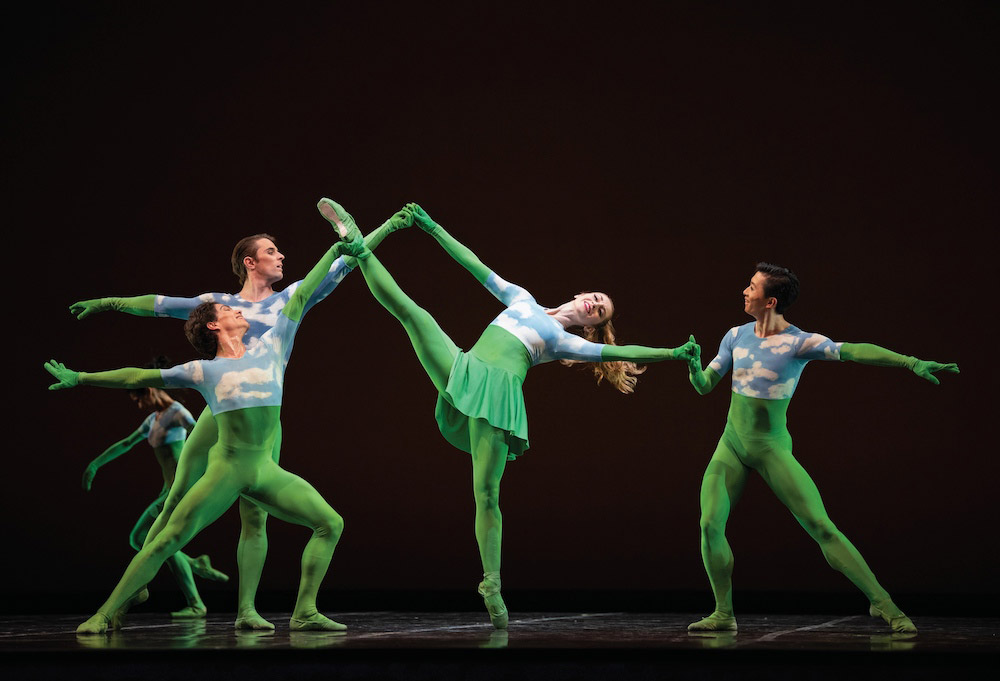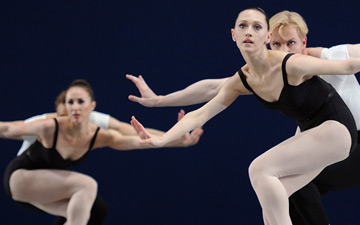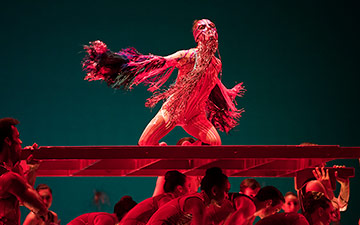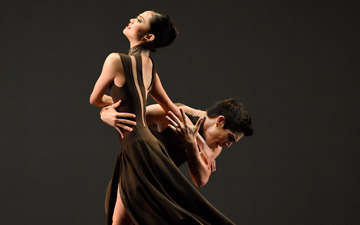
© Erik Tomasson. (Click image for larger version)
San Francisco Ballet
Classical Re(Vision): Bespoke, Foreshadow, After the Rain pdd, Soirées Musicales, Sandpaper Ballet
★★★★✰
San Francisco, War Memorial Opera House
11 February 2020
www.sfballet.org
San Francisco Ballet’s Program 2, which opened Tuesday, was dubbed Classical Re(Vision) – a remembering of and reconnection with choreography in SFB’s existing repertory catalogue. Though in the light of events over the last few weeks, I found it impossible not to focus on the word ‘revision’ or the verb, ‘revise.’ Liam Scarlett’s Hummingbird was originally slated for this triple bill. But after his suspension from The Royal Ballet over allegations of sexual misconduct, SFB responded with the decision to pull the ballet and replace it. In very short order, a variable Director’s Choice segment, curated by Artistic Director Helgi Tomasson, was created to join Stanton Welch’s Bespoke and Mark Morris’ Sandpaper Ballet. A vital revision, it seems. And if opening night was any indication, the new program is solid – two strong works that celebrate music and movement complemented by a collection of short, powerful excerpts.
Original ballet vocabulary; specially crafted for SFB’s 2018 Unbound Festival; tailored to reflect a dancer’s journey through time. There are so many ways that Welch’s Bespoke lives up to its title. But for me, the work is at its bespoke best in its connection to the score, two violin concertos by J.S. Bach. A multi-chapter dance for twelve, Bespoke’s choreography captures the layers and textures of the varied Baroque music, conducted by Martin West with Cordula Merks on the violin. Following a brief meditative ballet class-style sequence, the entire space exploded with joy. Swinging, leaping and bounding, the cast took the stage with gusto, the same jubilance emanating from the orchestra. Dancers appeared from the back of the stage as if conjured, as melodies similarly arose out of nowhere to claim attention. A robotic port de bras sequence emphasized the staccato passes in the composition. And in that same scene, clad in Holly Hynes’ Greco-Roman style costumes, the stage looked like a sea of living statues, if this was the only spot I felt the costumes fit the piece.
Bespoke’s central pas de deux, danced at this performance by Mathilde Froustey and Carlo Di Lanno, fascinates in its dramatic oscillation between consonance and dissonance. In one instant, the dancers seem totally in sync and then all of sudden, they’re not. As I encountered this section again, I wondered if perhaps that tension is another reflection of Bach’s score – the pair embodying the complex subject/answer relationship found in a fugue. Sometimes things line up and sometimes they don’t. On that theme of structure, a trio for three women had contrapuntal energy to spare. And one of the men’s sequences brought the invention musical form to the table, where two lines of choreographic inquiry have a chance to converse.

© Erik Tomasson. (Click image for larger version)
The Director’s Choice selections were up next: Val Caniparoli’s Foreshadow, the pas de deux from Christopher Wheeldon’s After the Rain and Tomasson’s Soirées Musicales. A recent debut from January’s gala evening, Foreshadow looks to the novel Anna Karenina for inspiration. The resulting trio is filled with charged, sinuous, lush movement: splaying wrists, jutting ribs and shoulders that circle almost to the point of dislocation. Foreshadow definitely accomplishes an atmosphere of abandon and urgency, though I’m not sure whether a narrative comes through in its brief seven minutes. With a distinct sense of forward motion, the pas de deux from 2005’s Rain is a visual stunner – a gentle, flowing series of potent sculptural images. Two dancers sway side to side; a perfectly turned out passé morphs into a purposely turned-in sickled one; hips bridge; the back bends; and of course, an iconic posture of suspension. Yuan Yuan Tan and Luke Ingham were perfection from beginning to end. 1996’s Musicales was a celebration of technique, an upbeat, very pretty, classical grand pas de deux. Gallant and regal movements abounded as did sparkling steps: huge jeté entrelaces, Russian pas de chats and fantastical fouettés. Misa Kuranaga and Angelo Greco were indeed the right technicians to bring the work to life. As lovely as it was to watch, Musicales felt out of place in the program, lagging a little after Foreshadow and Rain. Perhaps as the opener for Program 2’s middle section, it would have faired better.

© Erik Tomasson. (Click image for larger version)
In contrast, Morris’ Sandpaper Ballet (1999) was an ideal finale for the night, a fun, whimsical romp (albeit a little on the long side) set to an array of catchy Leroy Anderson tunes. With an orchestral prelude of Sleigh Ride, moving to The Typewriter, Sandpaper established its cinematic, nostalgic tone right from the beginning. Morris’ choreography for the cast of twenty-five (!) was equally wistful as were Isaac Mizrahi’s unforgettable green costumes. Long slides, cheery pas de basques, swoony batterie phrases all felt like they could have been straight out of a 1950s movie musical. The men shone in laid back combinations peppered with old-school soft shoe. A luscious tango arose. And Jennifer Stahl’s relevé footwork circuit was a highlight. Precision and timing proved difficult for the corps women from time to time, something that has been creeping into other repertory of late too. In any event, the genius of Sandpaper is that it doesn’t take itself too seriously, it is about the dance, but really about the fun of the dance, and the cast was all in for the ride.

















You must be logged in to post a comment.